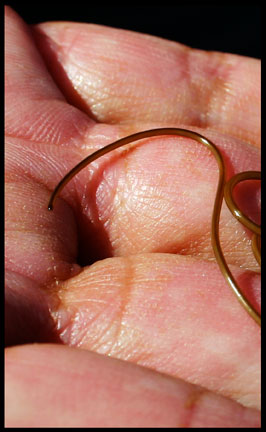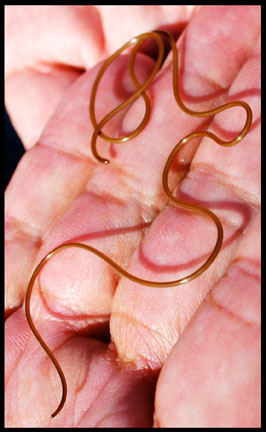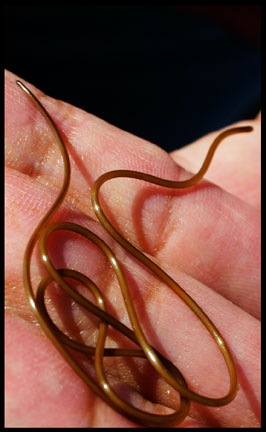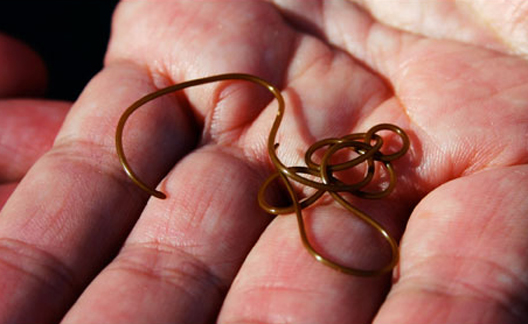Horse Hair Snake
by Joshua Heston
Yessir, hairsnakes look like snakes.
They’re more common in Ozark rivers that you might think, with folks in Shannon County, Missouri, finding mats of them in the fast flowing waters of the Current River.
These small creatures are not, however, snakes at all.
They are members of the nematode family (long, unsegmented parasitic worms found in both soil and water).
They seemingly tie themselves in knots, gather in clusters (much like garter snakes) to mate, and feed upon small insects and fish.
What is further theorized is that the hairsnake, upon growing within a terrestrial insect host (like a cricket) emits a chemical affecting the mind of its host, causing the insect to return to water and drown itself.
Thus the hairsnake returns to its habitat.
Who knows if that is true?
I certainly don’t, but it is interesting — and creepy — nonetheless. A great article (quoted below) further explains hairsnake (or hairworm) characteristics.
From Vance Randolph:
If a single horsehair is placed in water, in the summer time, it is believed to turn into a snake. This notion probably arose from the fact that long hairlike worms, said to mature in the intestines of grasshoppers, are sometimes seen in watering troughs and roadside pools.
I found one of these creatures once in my springhouse in Pineville, Missouri. It was about a foot long, white, and rather thicker than a horsehair. One end was tapered, the other blunt — the tapered end seemed to be the head. I kept the thing in an aquariam for several days. It was always moving, the tapered end being the most active in exploring every crack and cranny as if seeking a way out. Later on some boys showed me another horsehair snake they had found in a creek. This one was about five inches long, dark brown in color, and very active. It really looked pretty much like a piece of horsehair, and the boys who found it had no doubt that it was a horsehair which, in the natural course of events, had “turned into a snake.”
— page 253-254, Ozark Superstitions by Vance Randolph, Columbia University Press 1947
DO HAIRWORMS MANIPULATE THE WATER SEEKING BEHAVIOR OF THEIR TERRESTRIAL HOSTS?
The Nematomorpha is a relatively unknown taxon which contains about 300 species distributed around the world and commonly called hairworms (Schmidt Rhaesa, 1997).
Adult males and females are free-living in aquatic environments and gather together to mate in tight masses (i.e., a gordian knot).
Unlike adults, juveniles are parasitic in arthropods. Hosts (mainly terrestrial insects) become infected with hairworms when the engest parasitic larvae (directly or indirectly through a paratenic host, see Hanelt & Janovy, 1999; Schmidt Rhaesa, 2001.
During their development, nematomorphs grow from a microscopic larva to a worm whose size exceeds the length of the host by a considerable amount. Indeed, when the parasitic development has been completed, the worm occupies most of the host cavity with the exception of the head and legs.
Worms are only ready to emerge once they reach this stage.
Based on several anecdotal observations, it has often been hypothesized that mature nematomorphs manipulate the behavior of their terrestrial insect host making them seek water and jumping into it (see Blunk, 1922; Thorne, 1940; Dawkns, 1990; Poinar, 1991; Begon et al., 1996; Schmidt-Rhaesa, 1997).
“Do hairworms (Nematomorpha) manipulate the water seeking behavior of their terrestrial hosts?”
by F. THOMAS, A. SCHMIDT-RHAESA, G. MARTING, C. MANU, P. DURAND & F. RENAUD.
J. EVOL. BIOL. 15 (2002) 356-361
Plate 1.

Plate 2.

Plate 3.

Plate 4.

Plate 5.




